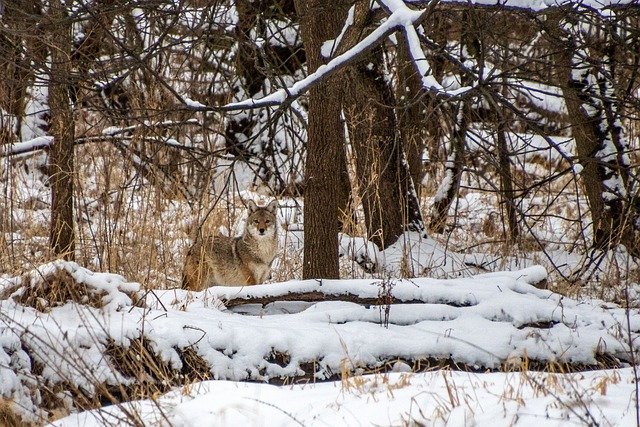Seeing a coyote in certain situations can be concerning for some individuals.
Table of Contents
The Potential Dangers of Encountering a Coyote
Is it bad to see a coyote? Well, encountering a coyote can be an exhilarating experience for some, but it’s important to be aware of the potential dangers that come with it. While coyotes are generally shy and elusive creatures, there are certain situations where their behavior can become a cause for concern.
One of the main dangers of encountering a coyote is the risk of an aggressive encounter. Although rare, there have been instances where coyotes have attacked humans, especially if they feel threatened or cornered. It’s crucial to remember that coyotes are wild animals and should be treated as such. Approaching them too closely or attempting to feed them can provoke defensive behavior, leading to potential harm.
Another concern when it comes to coyotes is their interaction with pets. Small dogs and cats can be seen as prey by coyotes, and there have been numerous reports of pets being attacked or even killed by these cunning predators. It’s essential to keep a close eye on your pets when in areas known to have coyote populations, and to never leave them unattended, especially at night. Keeping your pets on a leash and ensuring they are up to date on their vaccinations can also help minimize the risk.
Coyotes are known to be carriers of various diseases, including rabies. While the chances of contracting rabies from a coyote are relatively low, it’s still important to exercise caution. Avoiding direct contact with coyotes and ensuring that your pets are vaccinated against rabies can help protect both you and your furry friends.
In addition to the potential dangers they pose to humans and pets, coyotes can also cause damage to property. They are opportunistic scavengers and have been known to raid garbage cans, gardens, and even livestock. To minimize the risk of property damage, it’s advisable to secure trash cans and compost bins, remove any potential food sources from your yard, and consider installing fencing or other deterrents if you live in an area with a high coyote population.
While encountering a coyote can be thrilling, it’s crucial to prioritize safety and take necessary precautions. If you do come across a coyote, it’s best to keep your distance and observe from afar. Avoid making sudden movements or loud noises that may startle the animal. If you feel threatened or if the coyote displays aggressive behavior, it’s important to back away slowly and calmly, without turning your back on the animal.
In conclusion, seeing a coyote can be an exciting experience, but it’s important to be aware of the potential dangers that come with it. Aggressive encounters, risks to pets, the transmission of diseases, and property damage are all factors to consider. By taking necessary precautions and respecting the wild nature of coyotes, you can enjoy their presence while ensuring the safety of yourself, your pets, and your property.
Understanding Coyote Behavior and How to React

Is it bad to see a coyote? That’s a question that many people ask themselves when they spot one of these elusive creatures in their neighborhood or while out on a hike. The answer is not as straightforward as you might think. Understanding coyote behavior and knowing how to react can help you navigate these encounters with confidence.
Coyotes are native to North America and are highly adaptable animals. They have successfully expanded their range into urban and suburban areas, which means that sightings are becoming more common. While some people may feel alarmed or fearful when they see a coyote, it’s important to remember that these animals are generally not a threat to humans.
Coyotes are primarily nocturnal animals, which means that they are most active during the night. However, it’s not uncommon to see them during the day, especially in areas where they have become accustomed to human presence. If you do spot a coyote, it’s important to remember that they are usually more afraid of you than you are of them. They will typically try to avoid human contact and will retreat if they feel threatened.
It’s important to note that coyotes are opportunistic feeders and will scavenge for food wherever they can find it. This means that they may be attracted to residential areas where there is easy access to garbage or pet food left outside. To minimize the chances of attracting coyotes to your property, it’s important to secure your garbage cans and bring pet food indoors. By removing these potential food sources, you can help discourage coyotes from frequenting your neighborhood.
If you do encounter a coyote, it’s important to remain calm and avoid any sudden movements. Keep a safe distance and do not approach the animal. It’s also a good idea to make yourself appear larger by raising your arms or opening your jacket. This can help deter the coyote from approaching you.
In rare cases, a coyote may exhibit aggressive behavior towards humans. This is usually a result of habituation, where the animal has become too comfortable around humans and has lost its natural fear. If you encounter an aggressive coyote, it’s important to stand your ground and not run away. Running can trigger a chase response in the coyote, which can be dangerous. Instead, make loud noises, throw objects towards the coyote, and try to scare it away.
It’s also important to remember that coyotes are an important part of the ecosystem. They help control populations of rodents and other small mammals, which can be beneficial for farmers and gardeners. By understanding and respecting their behavior, we can coexist with these fascinating creatures.
In conclusion, seeing a coyote is not necessarily a bad thing. They are generally not a threat to humans and will try to avoid contact whenever possible. By understanding their behavior and knowing how to react, we can ensure peaceful coexistence with these adaptable animals. So, the next time you spot a coyote, take a moment to appreciate their presence and remember that they play an important role in our ecosystem.
Coyote Encounters: Tips for Ensuring Safety
Is it bad to see a coyote? Well, it depends on the context. Coyotes are wild animals that are commonly found in North America, and while they may seem harmless from a distance, it’s important to exercise caution when encountering them. In this article, we will discuss some tips for ensuring your safety during coyote encounters.
First and foremost, it’s essential to understand that coyotes are generally shy and elusive creatures. They prefer to avoid human contact and will typically run away if they see or hear people approaching. However, there are instances where coyotes may become more bold or aggressive, especially if they have become habituated to humans or if they feel threatened.
One of the most important things to remember when encountering a coyote is to never approach or attempt to feed them. Feeding coyotes can lead to habituation, where they lose their natural fear of humans and become more comfortable in residential areas. This can result in increased conflicts and potential dangers for both humans and coyotes.
If you do come across a coyote, it’s best to keep your distance and give them space. Maintain eye contact and make yourself appear larger by raising your arms or opening your jacket. You can also make loud noises or throw objects near the coyote to scare them away. It’s important to note that while these actions may deter a coyote, they should only be used as a last resort and in situations where the coyote is exhibiting aggressive behavior.
Another important tip is to keep your pets on a leash and supervise them when outdoors, especially during dawn and dusk when coyotes are most active. Small pets, such as cats or small dogs, can be seen as prey by coyotes, so it’s crucial to keep them close and avoid leaving them unattended in areas where coyotes are known to frequent.
If you live in an area with frequent coyote sightings, it’s a good idea to secure your garbage cans and eliminate any potential food sources that may attract them. Coyotes are opportunistic scavengers and will take advantage of easily accessible food. By removing these temptations, you can reduce the likelihood of attracting coyotes to your property.
In some cases, coyotes may become more persistent or aggressive, posing a potential threat to human safety. If you encounter a coyote that is acting aggressively, such as approaching you or your pets without fear, it’s important to report the incident to your local wildlife authorities. They can provide guidance on how to handle the situation and may take necessary measures to address the issue.
In conclusion, seeing a coyote in itself is not necessarily bad, as they are a natural part of the ecosystem. However, it’s crucial to exercise caution and follow these tips to ensure your safety and the well-being of both humans and coyotes. By understanding their behavior and taking appropriate measures, we can coexist with these fascinating creatures in a safe and respectful manner.
The Ecological Role of Coyotes and Their Impact on Urban Areas
Is it bad to see a coyote? This is a question that often comes up when people spot these elusive creatures in urban areas. While some may feel a sense of fear or concern, it’s important to understand the ecological role that coyotes play and their impact on urban environments.
Coyotes are native to North America and have adapted well to various habitats, including urban areas. They are highly adaptable and can survive in a range of environments, from forests to deserts. In recent years, coyotes have become more common in cities and suburbs, leading to increased sightings and encounters with humans.
One of the reasons why coyotes are thriving in urban areas is their ability to find food. They are opportunistic eaters and have a diverse diet that includes small mammals, birds, reptiles, and even fruits and vegetables. In urban environments, they can scavenge for food in garbage cans, hunt rodents, or even feed on pet food left outside. This adaptability allows them to find sustenance in areas where other predators may struggle.
Coyotes also play an important ecological role in urban areas. They help control populations of small mammals, such as rats and mice, which can become pests in cities. By preying on these animals, coyotes help maintain a balance in the ecosystem and reduce the risk of disease transmission. In fact, studies have shown that areas with coyotes have lower rates of Lyme disease, as these predators help control the population of ticks, which are carriers of the disease.
While coyotes are generally not a threat to humans, it’s important to take precautions when encountering them. They are naturally wary of humans and will usually avoid direct contact. However, if they feel threatened or cornered, they may display defensive behaviors. It’s best to give them space and not approach or feed them. Keeping pets on a leash and supervising them when outside can also help prevent conflicts with coyotes.
In some cases, coyotes may become habituated to human presence, especially if they are fed or have easy access to food sources. This can lead to bolder behavior and an increased risk of conflicts. It’s important for communities to implement measures to discourage coyotes from becoming too comfortable in urban areas. This can include securing garbage cans, removing potential food sources, and educating residents about coyote behavior and how to coexist with them.
Overall, seeing a coyote in an urban area is not necessarily a bad thing. It’s a reminder of the resilience and adaptability of wildlife in the face of human development. Coyotes play an important ecological role and can help control populations of pests in cities. By understanding their behavior and taking necessary precautions, we can coexist with these fascinating creatures and appreciate the diversity of wildlife in our urban environments. So, the next time you spot a coyote, take a moment to appreciate their presence and the role they play in our ecosystem.
Conclusion
Seeing a coyote is not inherently bad, but it is important to exercise caution and take appropriate measures to ensure personal safety and the well-being of the coyote and its natural habitat.
For licensing reasons, we must provide the following notice: This content was created in part with the help of an AI.


